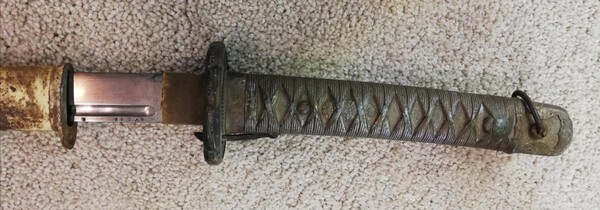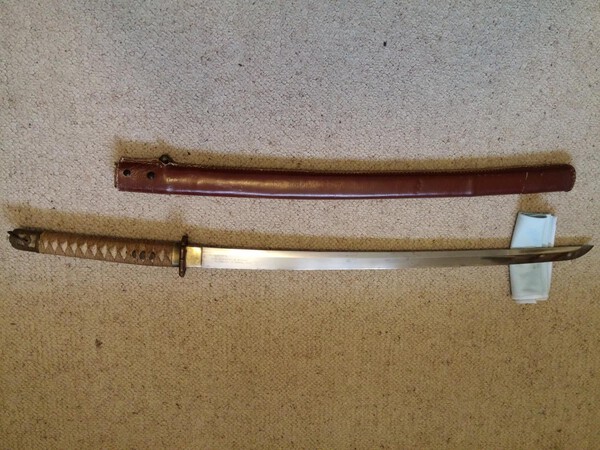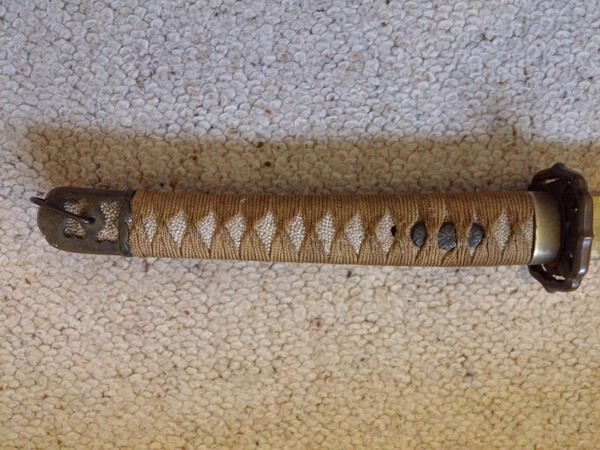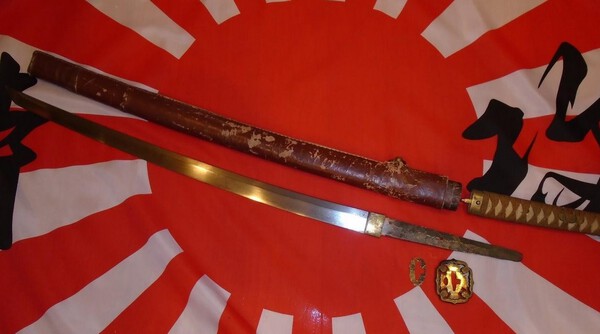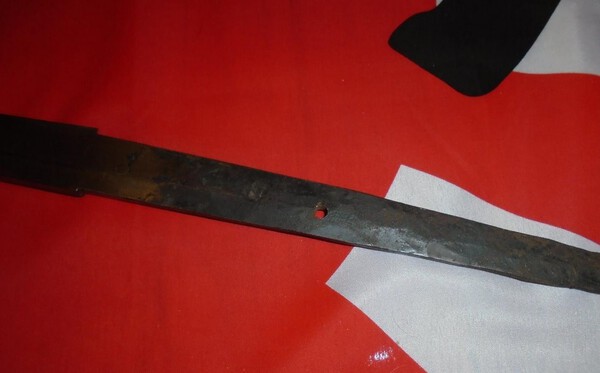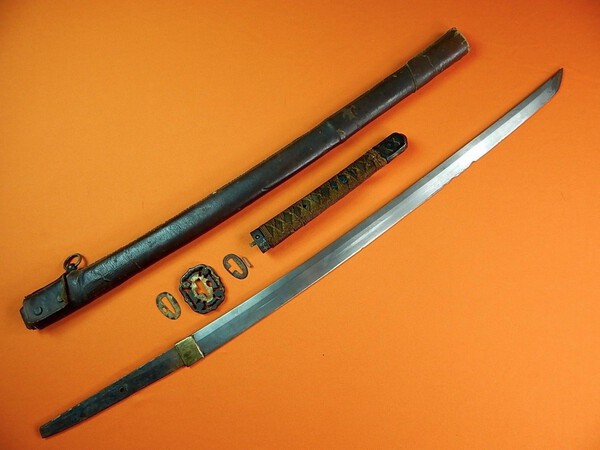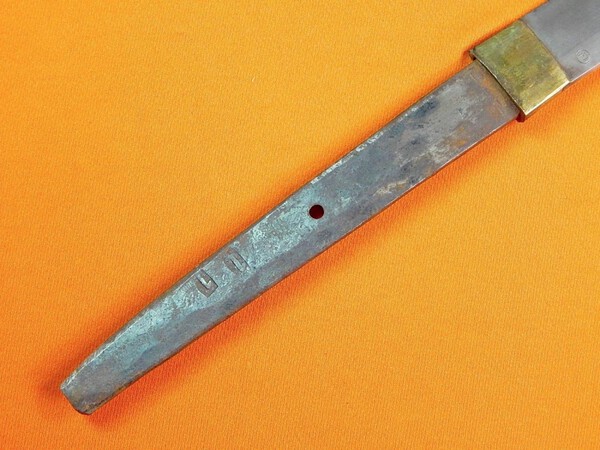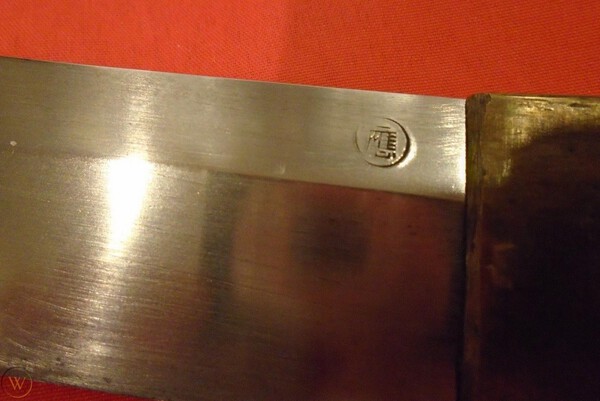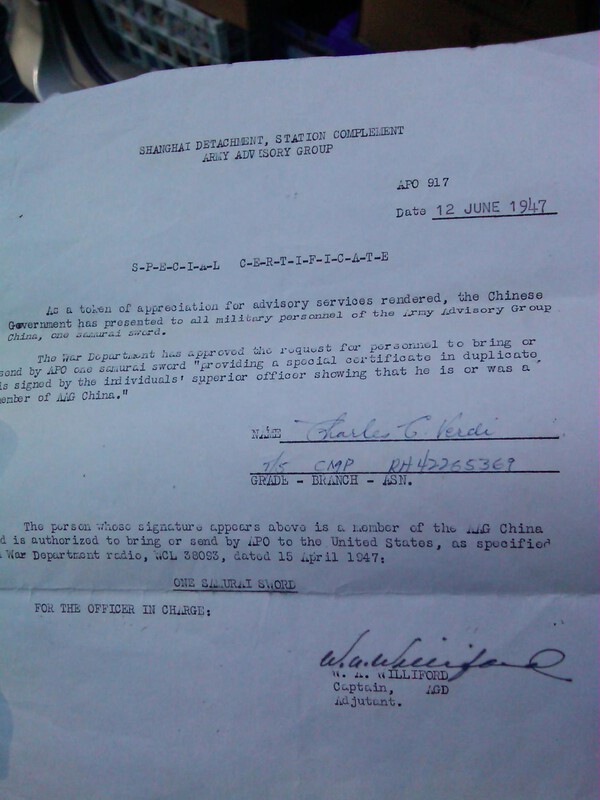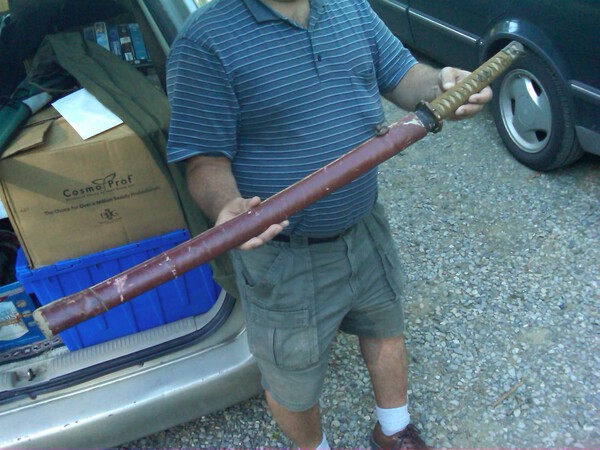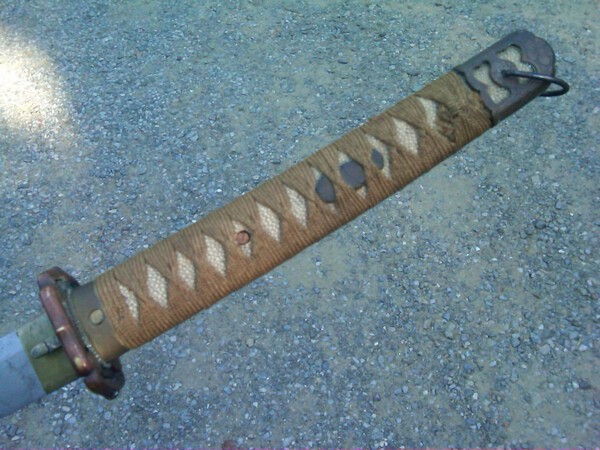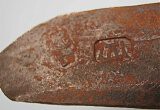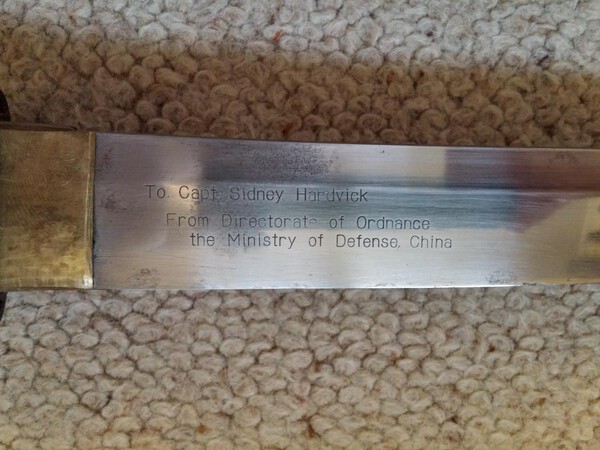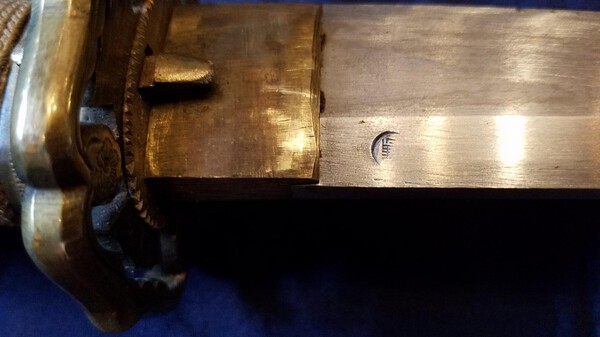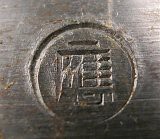-
Posts
1,402 -
Joined
-
Last visited
-
Days Won
12
Content Type
Profiles
Forums
Events
Store
Downloads
Gallery
Everything posted by Shamsy
-
I particularly appreciate that the sword was shortened, so it goes to show that it was a preference, at least in this case.
-
Blade patina varies extensively, so that's a poor indication of fakes. Black saya are period, (though not original) so that too is a poor indication. The font of the numbers is a far better indication of authenticity than trying to determine whether they are stamped or carved. The distance of the hanger ring on the saya varies, so again, not a good indication of whether a sword is genuine. One must look holistically at the sword to determine what can be considered 'fake' or otherwise. I still recommend that should anyone be in doubt, make reference to the thread we have regarding fake 95s which has a number of examples of the various details that give these swords away.
-
Hope Bill doesn't mind me using his photo, but he has posted this on the board before... Seen a couple of these. They have a second screw drilled and the tsuba has been replaced with a plain iron one, but of the correct thickness. The coppers all had thicker tsuba than later patterns, so an ordinary iron tsuba wouldn't fit, though there are a few rare examples of pattern 5 with thicker tsuba, but I digress. There was one for sale in UK a few years ago, but the asking price was beyond stupid, even for a rare and valuable copper, not to mention the missing saya, so I happily passed it up without regrets (rare to not regret missed swords nowadays).
-
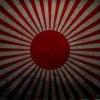
Are Contengency Gunto (Type 3) Underpriced?
Shamsy replied to Bruce Pennington's topic in Military Swords of Japan
Technically, the army would have officially designated it 九八式呂号軍刀, Type 98 Model B Sword. But it has so many names now, Type 3 or 0 is the common, if misleading name. -
There are legitimate examples of coppers that have a second screw added later. More telling is the incorrect ito pattern.
-
Ignoring everything else, the stamps alone show the sword as a fake. The real 95 stamps are well struck, well spaced and quite attractive. These are horrible imitations. Please feel free to add this example to the fake 95 thread, Brian.
-
It'd have to be a spectacular prize for me to most likely throw money away for a minute chance of winning. There are all sorts of laws and restrictions on 'prizes', at least in Australia. You need to jump through all sorts of hoops. Then you open yourself up to legal challenges, was the draw conducted fairly? How? Witnesses? Truly random... I'd hate to even try. EBay is about as close as I think you can get to a successful raffle. But don't let me stop you. I'm just sharing the thoughts and apprehensions I would have in this situation.
-

Fine Nihonto in the BEST ARMY MOUNTS to be Found
Shamsy replied to matthewbrice's topic in For Sale or Trade
Absolutely gorgeous koshirae, Matt. Well priced too for a traditional blade in what appears to be top condition. If I collected officer swords, this would be an irresistible package. Good luck with the sale. -
It does seem to vary vastly, but they're all reasonably similar from what I've seen. Usually a typed slip with a couple of fields to fill in. Yours has all the signs of age, so you can be pretty confident. As I mentioned, the sword descriptions are about as vague as you can get, so it's not really a given that any certification is actually attributed to a given sword. I'm not saying it isn't the case, but like a 'story', better to pay for the items rather than what cannot be documented.
-
I've not seen a fake one... But they're pretty uncommon really. They usually just say 'Japanese sword' too, so very hard to attribute accurately. As usual, in both instances, it is best 'from the veteran' or their family.
-
The stamps are all over the place on loads of example. Sometimes in the wrong order, sometimes missing one or more. Looks so much better after your work. Good job. As to the why it was painted, I've spoken to a lady who's father brought home a 95 and painted it sky blue. Why? Well he must have liked it. I'd considered a documented case of the vet painting a sword a 'part of its history', but when you fins a randomly painted one, cleaning it up is a good thing.
-
Rotten cream is a good name for it. I've only one photo on hand to show you, which doesn't show much I'm afraid. Not all we're painted on tsuka. Some only saya. A lot of variation. Also, looking good on restoration so far. Old paint is far hardier. That silver if definitely done later and detracts from the sword.
-
Easy to dismantle and it'd aid you in cleaning no end. Only word of caution is that the never seem to fit back together quite as well. Oh, watch for the screw too. Constantly seeing these threaded and/mangled by over excessive force and bad fitting tools. They're only soft metal.
-
Loss of paint on a 95 does affect value after a certain point. It is one of the quickest ways to confirm authenticity too, so it would be a shame to lose any original paint on the tsuka. Of course saying that, the silver is horrendous and must go. I'm sure there would be a way to carefully work over and remove layers slowly, leaving some of the original tsuka paint. Maybe a very light cleaning agent and a lot of elbow grease. Try Simply Green (US product, but it's in Aus so maybe you can find some too). My feeling is that it would work well on some modern paints, but is less likely to affect older paints.
-
I don't believe there is any new primary evidence, so I can only go with my earlier conjecture that they are a private purchase 'upgrade'. My mantetsu has an aluminium saya. The koshirae on that sword is fantastic, one of the nicest I've seen (for standard military style fit out).
-
Wretched phone won't allow me to view. Could someone please post photos here?
-
Always let people know it was restored though. There was to be some degree of presentation with these swords. It is when people tart them up they lose all value in my eyes.
-
As Dave says. 'Crew gunto' is nothing more than a marketing term. Officers of all the armed forces wore katana and wakizashi, seemingly on personal preference.
-
Thanks for the input, Trystan. It's quite hard to get good translations for Chinese. That was my thoughts too. Imitation gunto for the collaboration forces. John: it's obviously up to each collector what value they place on these swords. My personal thoughts are that a collector of Japanese swords from WW2 should probably consider a good example of these swords as an important part of their 'extended' collection. I personally like a verified island sword and consider it of equal collection value (though not dollar) as any standard Type of officer sword. These to me are about the same. Of course I collect 95s, so they are outside of my collection anyway.
-
Sorry, took a long time to find in all the crap I've gathered over the years. Not much to be dug up, but some useful info around translations and some old pictures I have saved. Basically, there are two 'patterns', one is very shabby (couldn't find any reference pics and not for want of trying), the last sword pictured in 3 photos is the 'higher grade' one that is quite nicely made IMHO for a non-Japanese sword. It has an inscription you can see in earlier post. Nakago on all are crude, stamped with numbers and Chinese characters. Take a gander at the paperwork on the 4th sword listed. These swords are a fairly interesting subject without a lot of info or awareness. Anyway, onto some translation I saved: 1) The one stamp looks like 應 the verb ataru, one meaning 'to accept'. I don't know by whom this sword was accepted or OK'd. It does look like Chinese manufacture. 應 in Chinese is not used in the sense of acceptance though. In Chinese it is used as in this sentence " 我們應該去。" (Cantonese) "Ngo ying gai hueh. " " We should go. " Where 應 means 'should'. 2) These 應 marked swords are late war lowered standard swords probably made in China for local and Japanese officers. The Kanji 應 is an older style of the Kanji 応 which is most likely a shortened form of 応急 meaning "emergency", like those similarly 応 marked emergency T-99 rifles. All a bit indecisive, but my feeling is that these are genuine collaboration swords. They are quite well made, show a good aged patina and there are too many in old collections (and with paperwork) to discount offhand. But who knows, we need some primary sources to make anything more than a modestly educated guess.
-
Here are some photos of these Chinese collaboration swords. The flowers on the tsuba are plumb blossom I think... Been a while since we discussed these. There are two 'grades' of swords seen. One is very crude, one rather well made (pictures 1 & 2). Both have open work tsuba and I recall that upon the ends of the obviously not Japanese made nakago, there are hot stamps of characters. If this is actually news to anyone I can find all the old notes and photos I have on these.
-
Swords are certainly more expensive to buy from the US since Trump saved their economy from going further down the toilet. I'm just holding on until the Democrats get back in power and the value of the US dollar plummets again.
-

Mottled Green Paint on Type 95s
Shamsy replied to Bruce Pennington's topic in Military Swords of Japan
Ah, not the variation after all. I'd based that hope the look of the sword, but not the case this time. Even so, what I said about refurbished saya stands. -

Mottled Green Paint on Type 95s
Shamsy replied to Bruce Pennington's topic in Military Swords of Japan
Looks like the 'other collector' has a nice variation of the 95s. Ask them what the serial number of the sword and saya are Here's mine. Oh, remember that a number of swords were painted gold to celebrate... think it was the emperors birthday... I can't remember details, but pretty sure Nick gave us some info about that. Also, as is most obvious with copper handle, there were undercoatings and repainting of swords. I believe that all period black saya are repaints of original green/brown saya. -
Understood, Hamish. Ultimately while I myself am comfortable in my opinion, it is just that. I always try to welcome debate and it is important that we all do, because that's how we learn. I come across as very flippant in my reply, which my excuse would be that I'm rather stressed and tired right now. But excuses are like arse holes - they stink. Instead I apologise for my overly defensive reply.




